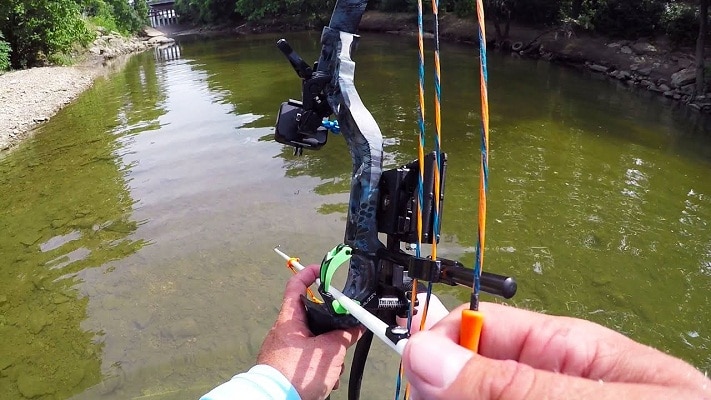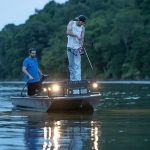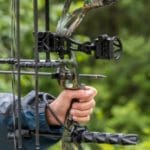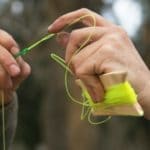Bowfishing is a fun way to spend an afternoon and an incredibly effective way to fill up a cooler with fish. But whether you are just getting started or you’ve been bowfishing for years, you’ll want to continue to refine your strategies and tweak your techniques to ensure you bring home the most fish possible.
We’ll try to help you accomplish exactly that, by sharing 11 helpful tips for improving your bowfishing success.
1. Make sure your bow is set up properly.

It may not be very fun, but you’ll want to make sure you tune your bow properly – especially if you’re having trouble hitting fish. This is the only way to ensure your arrows fly true, and it will help improve your hit-to-miss ratio. Paper tuning your bow isn’t terribly difficult, so take the time to learn how to do so.
Once you’ve tuned your bow and are satisfied with the results, be sure to check out your sight pin(s) too and make sure they’re dialed in.
Related: Can Any Bow Be Used for Bowfishing? (Take Our Advice)
2. Use a good pair of polarized glasses.
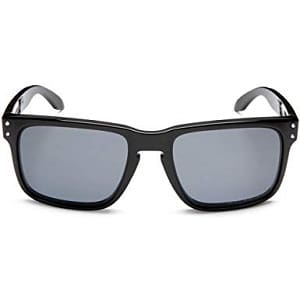
If you bowfish during the day, you’ll need a good pair of polarized glasses to help you see the fish more easily. The quality of polarized glasses varies wildly, so take your time and try to select a good pair that will fit your face comfortably – ideally, you should forget that you are even wearing them.
Also, be sure to use a good strap to prevent the glasses from falling into the water during the heat of the moment. You don’t want to spend $50 or $100 on a pair of good polarized glasses that end up on the bottom of the lake.
3. Use the best arrows for the job.
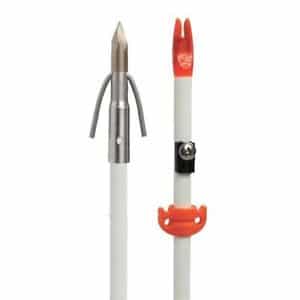
Ultimately, you’ll want to use the arrows that work best for you – regardless of what most other bowfishers choose to use. Same goes for a good bowfishing arrow rest.
However, for those who are just starting out, it is usually wise to follow the pack. Fiberglass arrows are typically the preferred choice, although carbon fiber arrows are becoming more popular among those who don’t mind the higher price.
Also, if you are new to bowfishing, it is important to note that bowfishing arrows shouldn’t have fletching. Not only can fletching complicate the process, but it is unnecessary when using the relatively heavy arrows most bowfishers prefer. Also, bowfishing shots are usually quite short, so fletching wouldn’t provide much value anyway.
4. Get out of the boat and wade when the fish are shallow.
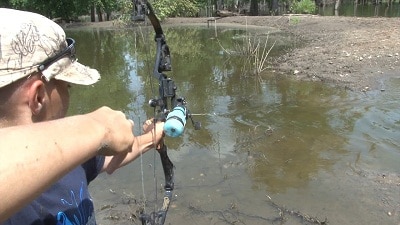
So, don’t be afraid to forego the boat and creep along the bank or wade into the water. Just be sure that you practice aiming and shooting while wading, as the angles are quite different than those you’ll encounter when bowfishing from a boat.
Related: 8 Best Bowfishing Boats: For Rivers, Lakes & Marshes
5. Practice shooting submerged targets.

The only way to do this consistently is via practice and muscle memory. Shooting arrows into a target in your backyard will never help you get a feel for the refraction effect, so you’ll need to set up some underwater targets and practice until it becomes second nature.
You can just rig up an underwater milk jug if you like, but there are also commercially produced targets that are designed for underwater use.
6. Emphasize a smooth draw when picking a bow.
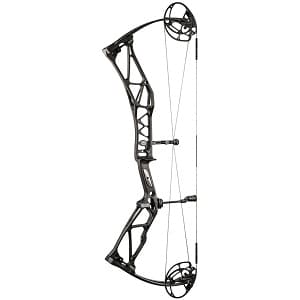
You can get started bowfishing with a hand-me-down beginner bow or one you picked up at a pawn shop. But eventually, you’ll likely get big by the bowfishing bug, and want to purchase your first “real” bowfishing bow.
When doing so, you’ll want to start by narrowing your choice down to three or four contenders that have the draw weight you desire and that feels good in your hand. And, of course, you’ll want to choose those that are in your price range and shoot accurately.
But, once you’ve narrowed down your potential options, you’ll want to make your final choice by selecting the one with the smoothest and most consistent draw. This is crucial for bowfishing success, and a smooth draw will help you to hit many more fish than a bow with a herky-jerky draw will.
7. Stick to a bottle-style reel while you are learning.

There are several different types of reels that can be used when bowfishing, including bottle-style reels, spincast reels and retriever reels, among others. Spincasting reels are some of the most popular reels for advanced bow fishers, and they provide a ton of benefits that other reels lack.
However, they’re often a poor choice for beginners. Bowfishing is often quite fast and furious, and it can be very easy to forget to release the spool or ensure your line isn’t tangled before firing an arrow. This can prevent the arrow from flying forward, resulting in “snap back,” which can lead to serious injuries.
By contrast, a bottle-style reel won’t present such dangers, as they’re much simpler to use. You’ll have to reel in your fish in hand-over-hand fashion, but that’s a minor price to pay for improved safety.
Related: Can You Use Regular Fishing Line For Bowfishing?
8. Consider using two-barb tips when working heavy cover.

Two-barbed tips, on the other hand, are much easier to free from dense vegetation or any other underwater cover. They are more likely to slip free of a fish’s body, but if you are shooting in shallow water, this is less likely to occur anyway. So, use your three-barbed tips when patrolling deep, open water, and switch to two-barbed tips when stalking the shallows.
9. Skip the release and use your fingers.
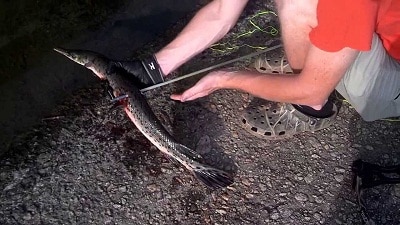
But that doesn’t mean you need to rip your fingers to shreds drawing the bowstring all day. Just use tabs, gloves or string sleeves to help protect your fingers, so you can concentrate on the fish.
10. Feel free to use a recurve bow if that suits you better.
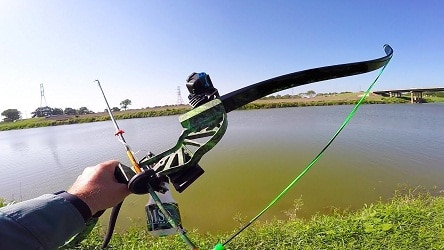
Recurve bows present a number of benefits to bowfishers. For example, they are often easier to shoot quickly than compound bows, and they are better suited for the kinds of half-draw shots that are often necessary when bowfishing. And, if you are simply more comfortable using a recurve bow, you’ll likely have much better success using one than you will if you force yourself to use a compound bow.
11. Try bowfishing at night.
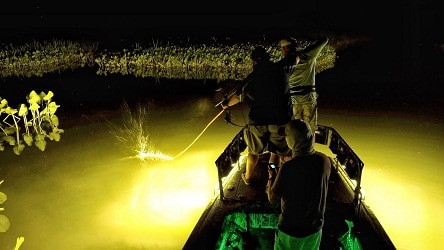
You’ll need to use a good lighting system to bowfish at night, and you’ll want to make sure that the deck of your boat is cleared of any obstacles, which may cause you to trip. But every bowfisher owes it to himself or herself to try bowfishing at night – you’ll be glad you did.
It’s pretty easy to learn how to bowfish – even first-timers will often have success. But, like most other outdoor sports, you can spend a lifetime perfecting your skills. So, be sure to head out to the water every chance you get, fire as many arrows as you can, and learn the best ways to maintain your bow.

